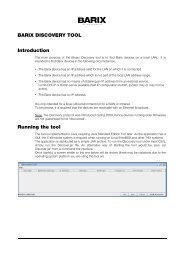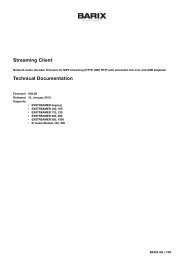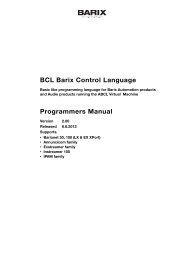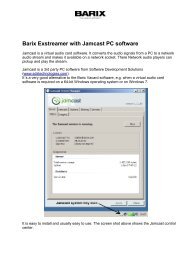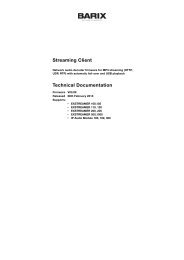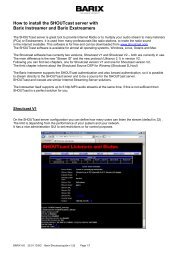ICPAGING Application User Manual - Barix
ICPAGING Application User Manual - Barix
ICPAGING Application User Manual - Barix
You also want an ePaper? Increase the reach of your titles
YUMPU automatically turns print PDFs into web optimized ePapers that Google loves.
8.1.9 VSCVolume Source Control unit. This an universal wall mountable control accessory for the <strong>Barix</strong> audioproducts range. It provides two digit LED display, control knob, and a IR port.8.1.10 IP AddressingAn IP address is a 32 bit value, divided into four octets of eight bits each. The standardrepresentation is four decimal numbers (in the range of 0..255), divided by dots.• Example: 192.2.1.123This is called decimal-dot notation. The IP address is divided in two parts: a network and a hostpart. To support different needs, five ”network classes” have been defined. Depending on thenetwork class, the last one, two or last three bytes define the host, while the remaining part definesthe network. In the following text, ‘x’ stands for the host part of the IP address.8.1.11 Class A network• IP address 1.x.x.x to 127.x.x.xOnly 127 different networks of this class exist. These have a very large number of potentialconnected devices (up to 16'777'216)• Example: 10.0.0.1 (network 10, host 0.0.1)8.1.12 Class B network• IP address 128.0.x.x to 191.255.x.xThese networks are used for large company networks. Every network can consist of up to 65534devices.• Example: 172.1.3.2 (network 172.1, host 3.2)8.1.13 Class C network• IP address 192.0.0.x to 223.255.255.xClass C networks are most common and for smaller companies. These networks can consist of amaximum number of 254hosts.• Example: 192.7.1.9 (network 192.7.1, host 9)8.1.14 Class D networkThe remaining addresses 224.x.x.x - 239.x.x.x are defined as ”Class D” and are used as multicastaddresses.8.1.15 Class E networkNo addresses are allowed with the four highest order bits set to “1” (240.x.x.x – 254.x.x.x).These addresses, called "class E", are reserved.44 Dictionary



